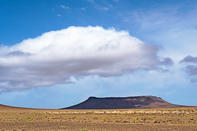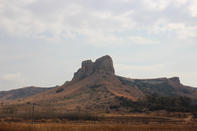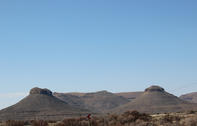A Vast Shallow Sea
Some 280 million years ago South Africa was emerging from the grip of the great Permian ice age. As the ice-sheets retreated the climate became more temperate and the central portion of South Africa was revealed as a low-lying basin.

A vast shallow sea covered the greater portion of Southern Africa, extending onto the South American continent, at that time positioned along the west coast of Africa as part of the great prehistoric southern land mass, Gondwanaland.
Mesosaurus, a semi-aquatic reptile which possessed a multitude of needle-like teeth and attained a maximum length of 2 metres, frequented this habitat and probably fed on another inhabitant, the small crayfish-like invertebrate Notocaris.
Over the next 90, million years the Karoo basin was inundated with rivers and streams depositing mud and sand, creating a lush marshland which was invaded and exploited by a completely different group of animals called the mammal-like reptiles. They were the dominant land vertebrates of their time and included groups such as the horny-beaked dicynodonts, the large lumbering dinocephalians, the rapacious flesh-eating gorgonopsians, therocephalians, and the highly advanced cynodonts.
First Primitive Mammals

Evolving gradually over a period of approximately 50 million years, the creatures finally gave rise to the first primitive mammals. Nowhere else on earth is this transition so well documented as in the rocks of the Karoo and that is the reason why this seemingly barren landscape has been hailed by scientists as one of the great natural wonders of the world.
The Karoo period was brought to a dramatic close by the massive volcanic outpourings of the Drakensberg lavas. This was a series of eruptions that covered most of the Karoo Basin, as well as other smaller, scattered areas right across the subcontinent. Only the mighty Drakensberg and Maluti Mountains remain of the basalts that were spewed out across the land, and which have been steadily eroded away since then. But it was the lava that did not find their way to the surface that eventually went on to give the Karoo its typical flat-topped koppies.
Basalt that is formed on the surface is relatively soft rock and therefore easily erodible. But when lava is squeezed between subsurface layers of rock, it is compressed and cools much more slowly than basalt, resulting in the formation of iron-hard dolerite. The Karoo mudstones are usually soft and easily chiselled away.
Beaufort Group Rocks

The Karoo's Beaufort Group rocks were laid down as mud and silt in a basin that then covered most of Southern Africa. Giant reptiles roamed the swampy ground, and there they died, to be preserved in the mud and fossilized to form shales.
Erosion has revealed these fossils, which lie like the text in the pages of the Karoo geological encyclopaedia. Now the swamplands have become semi-desert, fit only to cany sheep. Later, however, this area became the world's principal copper-producer, until the discovery of diamonds along the west coast in 1926 eclipsed the copper industry in the region.
Three Sisters

The dolerite caps that form the Three Sisters, between Beaufort West and Victoria West, once formed a continuous sill of rock. This 'iron rock' remains where the softer Beaufort shales have been eroded away, but in time even they will disappear. The plains that stretch out between Middelburg and Graaff-Reinet beneath the Bamboesberg, go under the name 'The Plains of Camdeboo'.
Barely a tree stands on them, and early explorers and Dutch farmers rather appropriately called these sun-scorched plains the 'Valley of Desolation'. By the agents of erosion, but where these forces hit upon hard dolerite sills, they leave behind flat-topped hills such as the Three Sisters. The correct name for these hills is 'mesas', and when the dolerite cap is eventually worn back to form a finger-like protrusion, it is called a 'butte'.